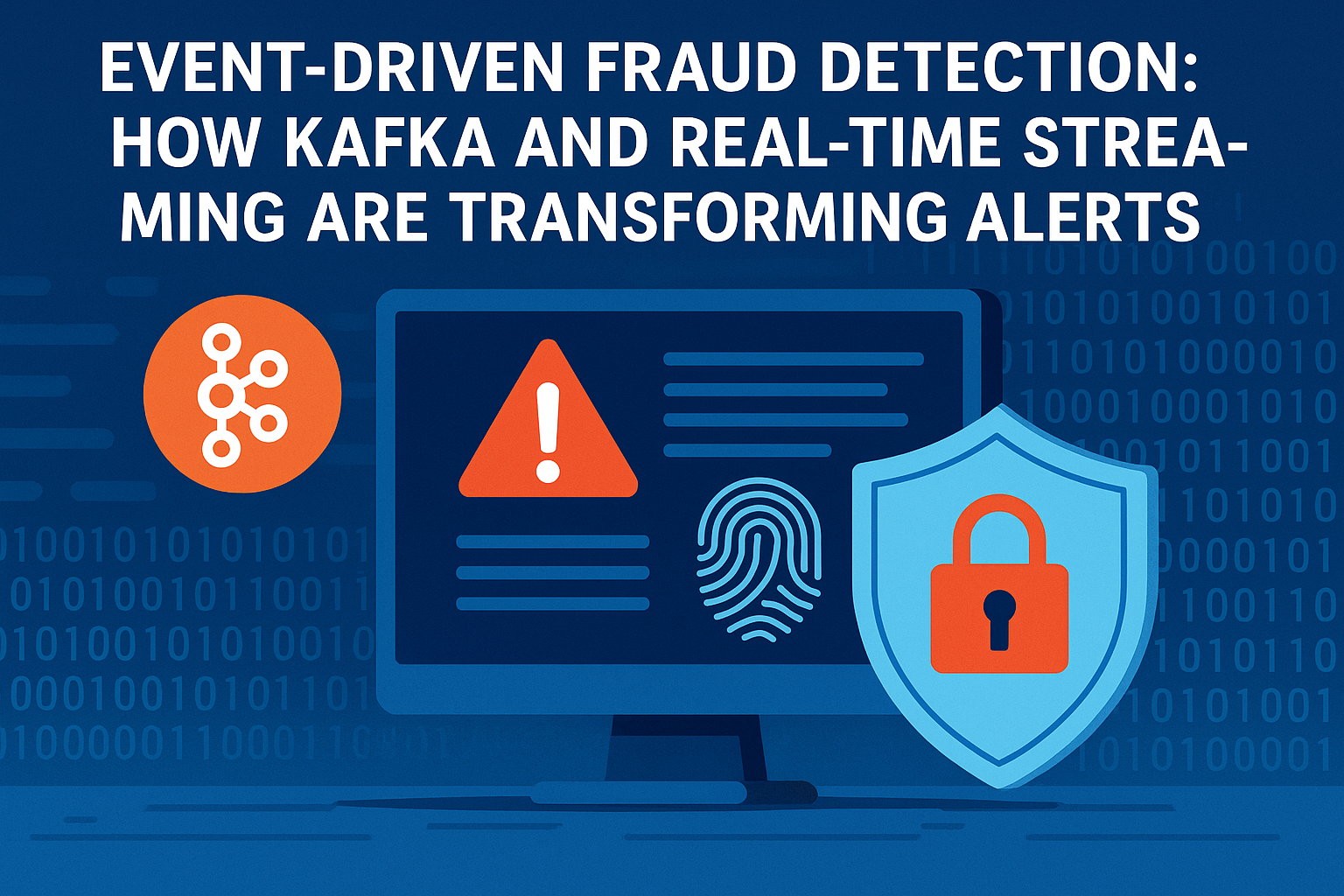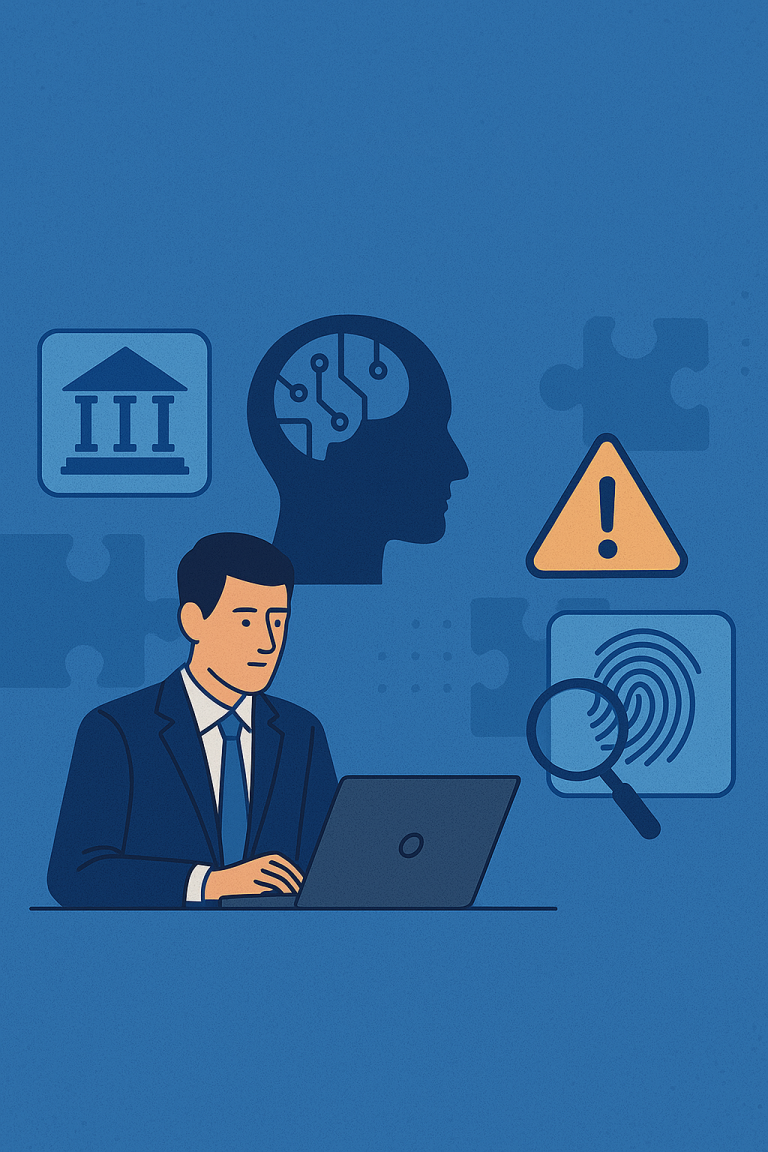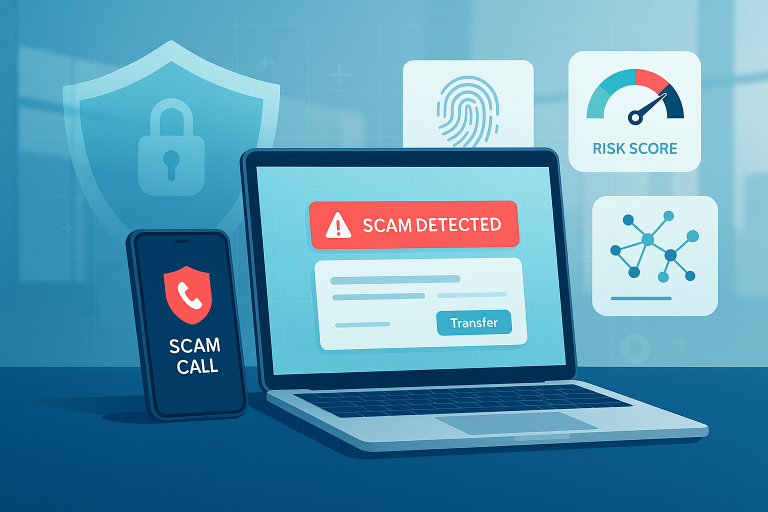1) From Batch Reports to Real-Time Defense
For years, banks relied on overnight jobs, static dashboards, and manual reviews to detect fraud. However, in an instant-payment world, by the time a batch job finishes, the fraud has often already completed. Consequently, organizations are shifting toward event-driven architecture (EDA) so they can act on every login, transaction, or device signal as it happens.
One flagship example underscores the shift: Bank of Ayudhya (Krungsri) reported detection-to-block latency in under 60 seconds after adopting Apache Kafka and stream processing — see this overview for details: Fraud Prevention in Under 60 Seconds with Kafka.
2) What Event-Driven Architecture Really Means
Essentially, EDA flips the model: instead of “data at rest → analytics → alert,” it becomes “event in motion → score → action.” When a user swipes a card or logs in, the system publishes a compact JSON event to a Kafka topic; then downstream consumers — rules engines, ML services, and alert systems — react immediately. Moreover, peer-reviewed work such as SCARFF (and the journal version in Information Fusion) demonstrates a Kafka → Spark → Cassandra pipeline that scales streaming credit-card fraud detection while tackling concept drift and class imbalance.
[DebitCardAuthEvent]
{
"account_id": "54218",
"amount": 184.30,
"lat": 29.47,
"lon": -98.49,
"device": "iPhone15",
"timestamp": "2025-10-19T12:04:33Z"
}
3) How Streaming Transforms Fraud Analytics
Streaming doesn’t just make detection faster; rather, it changes how analytics are designed and executed. For example, every event can be evaluated instantly (e.g., two ATM withdrawals 300+ miles apart within ten minutes). Furthermore, cross-channel correlation becomes natural: device, login, payment, and network signals are joined in flight to spot patterns invisible in siloed, batch systems.
Additionally, recent work reports streaming pipelines achieving high accuracy in real-time AML/fraud contexts. For one summary, see this (open-access) SCARFF text: SCARFF HTML (ar5iv). And for outcomes, a 2025 survey paper describes measurable improvements when institutions move from batch to streaming: IJSAT article page (PDF: download).
4) Architecture Blueprint
┌────────────────────────────┐
│ Event Sources │ (Payments, ACH, P2P, Logins, Devices)
└─────────────┬──────────────┘
│
[ Kafka Topics ]
│
┌──────────┴───────────┐
│ Stream Processing │ (Apache Flink / Spark / ksqlDB)
└──────────┬───────────┘
│
┌──────────┴───────────┐
│ Model Scoring API │ (Adaptive RF / XGBoost / DL + XAI)
└──────────┬───────────┘
│
┌─────────────┴───────────────────────────────────────────────┐
│ Cloud Data Platform (Snowflake Snowpipe Streaming) │
│ + Governance (Alation / Collibra / Schema Registry) │
└─────────────┴───────────────────────────────────────────────┘
│
Alerts → Case Mgmt → Analyst UX → Customer Notification
Therefore, you pair a high-throughput streaming backbone with governed storage and lineage. See: Snowpipe Streaming overview, classic architecture, and high-performance architecture. For design guidance, Confluent’s blueprint is helpful: Real-time Fraud Detection — Use Case Implementation.
5) Implementation Challenges & Lessons
- Concept drift: fraud patterns evolve. Accordingly, online frameworks such as ROSFD (Adaptive Random Forest + ADWIN) help maintain accuracy as distributions shift.
- Alert fatigue: real-time is always-on; therefore, tune thresholds, build feedback loops, and tier responses (approve / challenge / block).
- Schema drift: producers change payloads; thus, enforce versioned contracts (e.g., Schema Registry) to prevent silent breaks.
- Skill evolution: analysts must interpret signals, patterns, and windows — not just rows. For more fraud-program context, see our guide: How U.S. Financial Institutions Are Using AI to Combat Fraud.
6) U.S. Industry Snapshots & Capital One Deep Dive
U.S. Context
Major U.S. banks are not experimenting — they are operating. For instance, Capital One’s public materials describe event streaming as a first-class capability for risk and fraud: see their tech overview on event streaming and their earlier perspective on event streaming as an architectural style. Moreover, they continue to publish engineering guidance such as performance testing for EDA.
Capital One Case Study: Streaming as a Data Product
Problem: batch detection could not keep pace with digital speed, which increased exposure and eroded trust.
Solution: Capital One standardized on Kafka/Confluent and built a reusable, real-time streaming foundation. Specifically, the bank connects event producers (cards, deposits, authentication, device telemetry) to stream processors (Flink/ksqlDB) that perform windowed joins and velocity checks; a risk-scoring microservice executes approve-challenge-block decisions; Snowflake persists enriched streams for features and audit; and governance ensures trustworthy lineage. Additionally, Capital One engineers have written about using Apache Flink with AWS Kinesis Data Analytics to support real-time processing, which further demonstrates their cloud-native approach.
Results: Capital One treats fraud detection as a data product rather than a project. As a result, industry commentary and conference material attribute substantial per-customer fraud savings to streaming-based controls. Thus, streaming improves risk, reduces operational drag, and enhances customer experience (fewer false declines and faster resolutions). Finally, for a complementary perspective on fraud tactics and defenses, see our pieces on first-party fraud and account takeover prevention.
7) Looking Ahead: The Future of Event-Driven Fraud Detection
Moreover, the journey doesn’t end at “real time.” The next frontier is reflexive defense — systems that sense, learn, and act autonomously.
- Millisecond-class scoring: Kafka + vector embeddings (e.g., Redis) are delivering sub-100 ms decisions with strong precision/recall; therefore, sub-second SLAs will soon be table stakes.
- Hybrid AI + streaming: deep models (LSTM/Transformer) capture long-range behavior while stream processors handle stateful windows; consequently, hybrids lower false positives while boosting recall.
- Self-healing models: drift-aware frameworks (e.g., ROSFD) detect and adapt mid-stream, which maintains accuracy as patterns evolve.
- Edge & IoT: lightweight Kafka clients on ATMs and devices enable local scoring and send only anomalies upstream, thereby reducing latency and egress cost.
- Governance as the AI control plane: as speed increases, transparency must keep pace; thus, lineage and explainability become embedded in streaming paths.
8) Supplier Ecosystem (Quick Links)
- Streaming backbone: Apache Kafka • Confluent Cloud
- Stream processing: Apache Flink • ksqlDB
- Data platform: Snowflake Snowpipe Streaming
- Governance & lineage: Alation • Collibra
- Fraud AI platforms: NICE Actimize • Guardian Analytics (NICE)
- Monitoring/observability: Datadog • Grafana Loki
9) Key Takeaways
- Batch is broken for fast rails; therefore, detection must move to streaming.
- Streaming + governance yields sustainable modernization with lineage and auditability.
- U.S. leaders like Capital One prove the business case for event-first fraud controls.
- Next frontier: sub-100 ms scoring, drift-aware models, and explainable pipelines.
- Metric that matters: latency saved = losses prevented.
10) Conclusion
In short, event-driven fraud detection transforms how financial institutions fight fraud. By combining Kafka’s throughput, Snowflake’s governed analytics, and adaptive AI, organizations gain what criminals cannot replicate — context at the speed of action. Ultimately, advantage belongs to whoever processes the event first.
Related on EdEconomy
- Synthetic Identity Fraud: The Hidden Risk Behind Digital Onboarding
- First-Party Fraud in Banking: The Hidden Threat
- Account Takeover Fraud: Prevention Strategies & Top Tools
- How U.S. Financial Institutions Are Using AI to Combat Fraud
- Bank Scam Prevention: 2025 Field Guide for Fraud Analysts
References
- Carcillo, F., et al. (2017). SCARFF: A Scalable Framework for Streaming Credit Card Fraud Detection with Spark. (journal version: Information Fusion)
- Confluent (2025). Real-Time Fraud Detection — Use Case Implementation (whitepaper).
- Yelleti, V. (2025). ROSFD: Robust Online Streaming Fraud Detection with Resilience to Concept Drift.
- Wähner, K. (2024). Fraud Prevention in Under 60 Seconds with Apache Kafka (Krungsri). (open alternative: Medium version)
- IJSAT (2025). Real-Time Fraud Detection: Leveraging Apache Kafka and Spark for Financial Transaction Processing. (PDF: download)
- Capital One Tech Blog (2023). Event Streaming: Tips for Event-Driven Apps.
- Capital One Tech Blog (2018). Event Streaming as an Additional Architectural Style.
- Capital One Tech Blog (2023). Exploring Apache Flink & AWS Kinesis Data Analytics.
- Capital One Tech Blog (2025). Event-Driven Architecture: Performance Testing.








